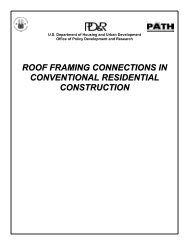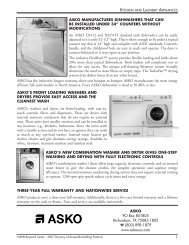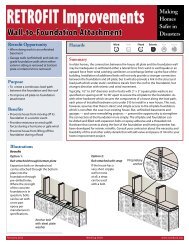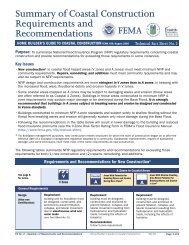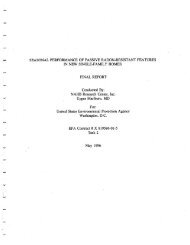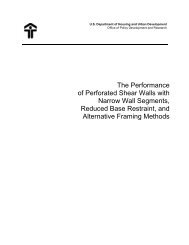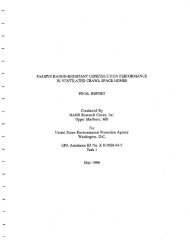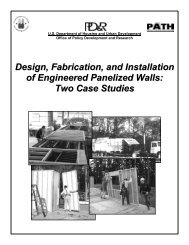5VAPOR RET ARDERS& AIR INFILTRATIONBARRIERS5.1VAPOR RETARDERESSENTIAL KNOWLEDGE32Vapor retarders first appeared in building construction in the 1920s. Early theories held that moisturevapor will migrate from a region of high concentration towards a region of low concentration along a linearpath. <strong>The</strong> amount of moisture transfer is dependent on the differences in concentration and the vaporpermeability of the membrane separating the two regions. This is the theory of vapor diffusion, whichviewed the flow of moisture vapor directly analogous to the conductive flow of thermal energy. In this theory,air movement, and the moisture propelled by it, were not considered to be major factors. In the early1950s, Canadian research found that air movement was the primary mechanism of moisture vapor migration.Without active air infiltration control, vapor retarder barriers become ineffective.Current theory on vapor retarders indicates that both air infiltration and direct diffusion playsignificant roles in the transfer of moisture vapor and, therefore, both must be accounted for. Effectivevapor retarders must have a water vapor permeability not exceeding 1.0 grains per hour per square footper inch of mercury vapor pressure difference (referred to as 1.0 perms), and must be installed in sucha manner as to prevent air leaks at joints and laps.Although the issue of what makes a vapor retarder effective is generally settled, controversy stillremains as to where to install it, if at all. From this standpoint, the authority on the subject is the 1997ASHRAE Handbook of Fundamentals, which has more to say on the topic than any of the model codes. Inwhat is defined as heating climates (4,000 heating degree days, base 65ºF, or more), vapor retarders belongon the interior side of the insulation. In warm, humid, cooling climates (Florida and Gulf Coast) where moisturevapor transfer conditions are effectively reversed, vapor retarders are best placed close to the exterior.In mixed climates (not fitting either of the above definitions), the vapor retarder should beplaced to protect against the more serious condensation condition, summer or winter. If in a mixed climatethe winter indoor relative humidity is kept below 35 percent, a vapor retarder at the interior side ofthe insulation is usually not required, and an exterior vapor retarder strategy is most effective. Where winterinterior humidity is not controlled or if a humidifier is used, an interior vapor retarder is most useful.Vapor retarders should never be placed on both sides of a wall. Where a vapor retarder isemployed, the opposite wall surface must provide a permeable surface to allow drying to occur. Thus, inhot, humid, cooling climates, where a vapor retarder is employed at the exterior, the interior wall surfacesshould be permeable. No vapor retarder paints, kraft-faced insulation, or vinyl wall coverings should beused. Conversely, in northern heating climates, with interior vapor retarders, the exterior wall coveringsshould be vapor permeable.<strong>The</strong> primary purpose for installing a vapor retarder in residential rehabilitation is to minimize
moisture vapor migration into a wall or roof assemly where it has the potential to deposit condensate whenthe dew point is reached. <strong>The</strong> resulting water in liquid form may cause decay in structural wood framing,wood-based sheathing materials, and interior gypsum board or plaster wall coverings. <strong>The</strong> prolongedpresence of moisture will also encourage and facilitate mold and mildew growth, raising potential serioushealth concerns for the homes’ occupants.TECHNIQUES, MATERIALS, TOOLSVapor retarders can be classified into two major groups: flexible or coatings. Metal foils, laminated foils,treated paper, and plastic films are flexible sheet goods, while paint, semi-fluid mastic, and hot melt arecoatings. In typical residential construction and rehabilitation, the commonly used materials are exteriororinterior-applied plastic films, interior-applied foil-faced products, interior treated paper-faced products,and interior paint coatings.1. APPLY A VAPOR RETARDER PAINT COATING.A relatively new product on the market suitable for interior applications is vapor retarder paint. Produced byseveral manufacturers, including Sherwin-Williams and Glidden, vapor retarder paints are available as interiorlatex primers, typically with a perm rating of approximately 0.7. <strong>The</strong>se primers are formulated to behave muchlike standard latex interior primers, in terms of consistency, coverage, and application. <strong>The</strong>y are tintable andsuitable for use over new gypsum board or previously painted surfaces. As with standard interior primers, normalprep work is needed, and stained areas will require a stain-hiding primer prior to application. <strong>The</strong> costper gallon of the vapor barrier primers is generally competitive with standard interior primers.ADVANTAGES: Vapor retarder primers are the simplest application in situations where existing wallboard orplaster surfaces are not to be significantly disturbed. Where interior primers are used, the vapor retarderfunction comes at virtually no additional cost. Can effectively upgrade the vapor transmission performanceof an exterior frame wall with no more effort and cost than a new primer and finish coat paint application.DISADVANTAGES: Appropriate for interior wall surface applications only. With the vapor retarder at the insidesurface of the wall assembly, damage to the paint can compromise retarding ability. If required prepriming prepwork is inadequate, the primer coat vapor retarder effectiveness will be diminished. To be fully effective, all penetrationsand material intersections at the interior surface of the wall must be caulked or otherwise sealed.2. INSTALL TREATED PAPER OR FOIL VAPOR RETARDERS.For residential rehabilitation purposes, treated paper and foil vapor barriers usually take the form of kraftand foil-faced batt installation. In a situation where interior wall finish has been removed and new exteriorwall insulation is to be installed, kraft or foil-faced batts are cost-effective and do provide an adequate to marginalvapor barrier. <strong>The</strong> amount of unsealed edge is significant and does provide a path for moisture vapormigration. To improve effectiveness, the kraft or foil flanges can be installed over the face of the studs andlapped instead of stapled to the inner stud faces (Fig. 1). Convenient and cost-effective, kraft and foil battinsulation facings do have limitations and their use as a primary vapor barrier should be limited to applicationswhere vapor barrier performance is not critical, such as in mixed, non-humid climates. In heating climateswith 4,000 degree days or more, a more continuous vapor barrier surface should be considered.ADVANTAGES: <strong>The</strong> most cost-effective interior vapor retarder strategy where exterior wall framing isexposed and new insulation is to be installed. Saves labor costs as fiberglass batt insulation and vaporretarder are installed in one step.DISADVANTAGES: Installation requires that walls are stripped to rough framing and that fiberglass batt insulationbe installed. <strong>The</strong> number of joints and edges inherent in this system make for a functionally marginal vaporretarder, but sufficient for mixed climates or where indoor humidity is controlled in heating climates.Performance can be improved by installing faced batts with flanges attached to narrow face of studs and lapped.33



